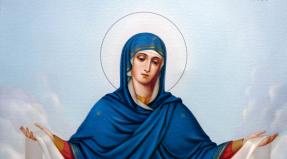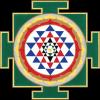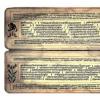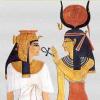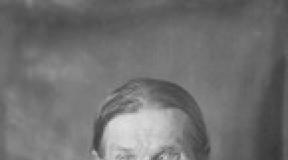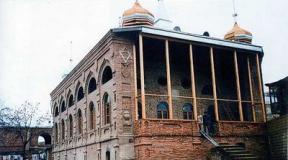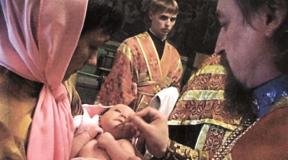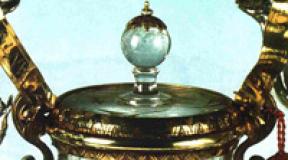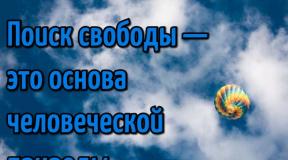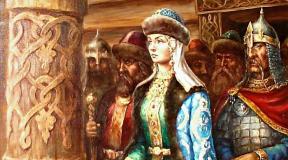What are the religious beliefs. What are the religions
All cheerful time of day! The concept of religions is found quite often in exams in the humanities. Therefore, I would recommend looking at these religions of the world, their list, in order to better navigate in them.
A little about the concept of "World religions". It often refers to the three main religions: Christianity, Islam and Buddhism. This understanding is not complete to say the least. Since these religious systems have different streams. In addition, there are a number of religions that also unite many people. Before publishing the list, I also recommend that you read the article about that .
List of world religions
Abrahamic religions - These are religions that go back to one of the first religious patriarchs - Abraham.
Christianity - briefly about this religion you can. It is presented today in several directions. The key ones are Orthodoxy, Catholicism and Protestantism. Holy book Bible (mostly New Testament). It unites today about 2.3 billion people
Islam - how religion took shape in the 7th century AD and absorbed the revelations of Allah to his prophet Muhammad. It was from him that the prophet learned that he had to pray a hundred times a day. However, Muhammad asked Allah to reduce the number of prayers, and as a result, Allah allowed to pray five times a day. By the way, the ideas about heaven and hell in Islam and in Christianity are somewhat different. Paradise here is the quintessence of earthly goods. The holy book of the Koran. It unites today about 1.5 billion people.
Judaism - the religion of the predominantly Jewish people, unites 14 million adherents. Most of all I was struck by the divine service: during its time you can behave quite naturally. Holy book Bible (mainly the Old Testament).
Other religions
Hinduism - unites about 900 million followers and includes faith in the eternal soul (atman) and in the universal God. This religion and others like it are also called dharmic - from the Sanskrit word "dharma" - things, the nature of things. The religious priests are here called brahmanas. The key idea is the rebirth of souls. Who cares, aside from jokes, look at Vysotsky: a song about the transmigration of souls.
Buddhism - unites over 350 million adherents. It proceeds from the fact that the soul is bound by the wheel of samsara - the wheel of reincarnation, and only work on oneself can allow it to escape from this circle into nirvana - eternal bliss. There are different branches of Buddhism: Zen Buddhism, Lamaism, etc. The sacred texts are called Tripitaka.
Zoroastrianism ("Good Faith") - one of the most ancient mono-test religions, incorporates faith in the one god Ahura Mazda and his prophet Zarathushtra, unites about 7 million people. Religion embodies belief in good and evil thoughts. The latter are the enemies of God and must be rooted out. Light is the physical embodiment of God and is worthy of veneration, therefore this religion is also called fire worship. Thus, in my opinion, this is the most honest religion, since it is thoughts that determine a person, and not his actions. If you agree with this - like it at the end of the post!
Jainism - unites 4 million adherents and proceeds from the fact that all living beings are eternally living in the spiritual world, calls for self-improvement through the education of wisdom and other virtues.
Sikhism - unites about 23 million adepts and includes an understanding of God as the Absolute and as a part of every person. Worship takes place through meditation.
Juche Is a North Korean political ideology that many refer to as a religion. It was formed on the basis of the transformation of the ideas of Marxism-Leninism and synthesis with traditional Chinese philosophy.
Confucianism - in the strict sense of the word, it is a more ethical and philosophical doctrine than religion and combines ideas about proper behavior, about ritual and about tradition, which, according to Confucius, must be represented. The main treatise is Lunyu. It consolidates about 7 million people.
Shintoism - this religion is prevalent mainly in Japan, so read about it.
Kao Dai - a fairly new religious system that appeared in 1926 and combines many of the principles of Buddhism, Lamaism, etc. Calls for equality between the sexes, for pacifism, etc. It originated in Vietnam. In fact, religion embodies everything that has been lacking in this region of the planet for a long time.
Hope you got an idea of \u200b\u200bthe world's religions! Like, subscribe to new articles.
Best regards, Andrey Puchkov
Over the past 10-odd years, Russia has witnessed a period of religious revival, the return of the population to traditional religious values. The mass of the country's population remained faithful to their religious convictions, as evidenced, in particular, by all objectively conducted recent opinion polls, as well as the desire of Russians to perform the most important religious sacraments and rituals (for example, such as the sacraments of baptism, chrismation, communion and marriage at Christians, circumcision and wedding ceremonies for Muslims and Jews, funeral rites for followers of various religions, etc.).
The most influential religion in Russia is christianity, and above all one of its most important directions - orthodoxy, which in our country is primarily Russian Orthodox Church... According to a sociological poll conducted in 2002, 58% adhere to Orthodoxy. If we proceed from the fact that the population of our country, according to the All-Russian Population Census, was 145.2 million people on October 9, 2002, then we can assume that the Orthodox Christians number in it approximately 84 million people.
Orthodoxy is professed by the bulk of the Russian population of the country, as well as the bulk of such as Izhorians, Vepsians, Sami, Komi, Permian Komi, Udmurts, Besermyans, Chuvashs, Kryashens, Nagaybaks,. The vast majority, Chulym, Kumandin, Chelkan, Shor, Ket, Yug, Nanai, Ulchi, Oroch, Itelmen, Aleuts, the predominant part, Selkups, Tubalars, Tofalars, Evens, Oroks, a significant part of the Enets, Telengits, small, Negidals call themselves Orthodox the number of Nivkhs, although many of the listed peoples of Siberia and the Far East combine the Orthodox faith with remnants of shamanistic and other local beliefs. Most of the Greeks and Bulgarians living in Russia are also Orthodox. Orthodoxy is also widespread among a part of the Western Buryats; it is adhered to by a part (primarily Don) and Mozdok Kabardians.
According to an expert assessment based on the existence of a certain correlation between religion and ethnicity, Orthodox Christians prevail among believers in the overwhelming majority of the constituent entities of the Russian Federation. The only exceptions are the Chechen Republic, the Republic of Ingushetia and the Republic of Dagestan, where there are few Orthodox Christians, as well as the Kabardino-Balkarian Republic, the Karachay-Cherkess Republic, the Republic of Kalmykia, the Republic of Bashkortostan, the Aginsky Buryat Autonomous Okrug, where Orthodox Christians, although they do not form the majority of the population, are represented very large groups (in some of these constituent entities of the Russian Federation they constitute only slightly less than half of the believers).
In addition to the Russian Orthodox Church, to which the overwhelming majority of the Orthodox population of our country belongs, there are several other Orthodox church associations and individual communities operating in Russia, but their number is very small. it Russian Orthodox Autonomous Church, church communities, subordinate Russian Orthodox Church Abroadcommunities recognizing leadership Kiev Patriarchate , different branches True Orthodox (catacomb) church,as well as scattered groups of so-called "True Orthodox Christians."The most famous community of the Russian Orthodox Autonomous Church is located in the city of Suzdal, Vladimir region; there are followers of this church organization in Moscow, Ufa, Tyumen, Ussuriisk (Primorsky Territory), Orenburg region, the Udmurt Republic and in a number of other places. There is a parish subordinate to the Russian Orthodox Church Abroad in Krasnodar, a parish subordinate to the Ukrainian Orthodox Church of the Kiev Patriarchate in the city of Ishim, Tyumen region. The number of followers of the Russian Orthodox Autonomous Church in Russia, as well as of Russian parishes of the Russian Orthodox Church abroad, totals 50 thousand.
In different places of Russia live old believers- Orthodox Christians who did not accept the reforms carried out by the Patriarch of the Russian Orthodox Church Nikon in the middle of the 17th century, which consisted primarily in bringing the liturgical books into conformity with those of the Greeks. Old Believers are divided into a large number of different groups, which can be divided into two branches: priests and bespopovtsy. Popovtsyinclude three main church associations of Old Believers: Russian Orthodox old Believer Church (Belokrinitskaya hierarchy), the Russian Old Orthodox Church and co-religionists.
Closest to the Russian Orthodox Church fellow believers- a group of Old Believers who preserved the service according to the old books, but submitted in 1800 to the leadership of the Russian Orthodox Church. Co-religionists themselves usually call themselves Orthodox Old Believers. Nowadays there are few united believers - according to rough estimates, from 6 to 12 thousand people. They are available in Moscow, St. Petersburg, Ivanovo, in the village of Bolshoye Murashkino (Nizhny Novgorod region).
Another church association of Old Believers-priests - Russian Orthodox Old Believer Church(Belokrinitskaya hierarchy) is the largest Old Believer organization in the country (about 1 million supporters). Having emerged in the Beglopop community (the Beglopopites received priests who had escaped from the Russian Orthodox Church), this church finally managed to create its own hierarchy in the middle of the 19th century. Most of the supporters of the Belokrinitskaya hierarchy are in, as well as in Moscow, the Moscow region, St. Petersburg, Saratov, the Republic of Buryatia, the Republic of Sakha (Yakutia), the Krasnodar Territory, the Perm and other regions.
Another association of Old Believers-priests is Russian ancient Orthodox church(according to various sources from 250 thousand to 500 thousand or more people). There are many followers of this church in Moscow, Moscow Nizhny Novgorod, Chita, Bryansk and other regions. In the Nizhny Novgorod region, they are concentrated primarily in the Semenovsky, Urensky, Gorodetsky districts. Recently, this church split, and from it the Old Orthodox Church of Russia, which enjoys the greatest influence in the Kursk Region and Krasnodar Territory, emerged. The Russian Old Orthodox Church itself is now officially called the Old Orthodox Patriarchate of Moscow and All Russia.
Popovtsy also include two small groups of so-called catacomb co-religionists, however, who do not maintain any relations with their fellow believers of the Moscow Patriarchate. it andreevtsy(about 10 thousand people) and clientele(5 thousand people). The former are found in the Republic of Bashkortostan and some regions of the Urals, in the Krasnodar Territory and Eastern Siberia, the latter also in the Urals, Siberia and the Far East.
There are much more unpopular associations of the Old Believers than priests. These are Chapel, Pomorskoe, Fedoseevskoe, Filippovskoe, Spasovo consent, runners, Ryabinovites, Melchizedeks, etc.
Followers Hourly consent do not consider themselves unpopular and consider the absence of the priesthood as a temporary phenomenon. Their total number is unknown, but, apparently, it now does not exceed 300 thousand people, although it was once much more significant. The chapels are settled mainly in the Perm, Sverdlovsk, Saratov and Tyumen regions, Altai Krai, Krasnoyarsk Krai and other regions.
Pomeranian, or danilovskoe, consent (the official name of this church association is Ancient Orthodox Pomor Church) stands out among the majority of pop-free consents for its moderation and is the most numerous of them (in Russia - 800 thousand people). Pomors live in Moscow, the Moscow region, St. Petersburg, the Republic of Bashkortostan, the Samara region, the Altai Territory and other places.
Close to Pomeranian Fedoseevsky consent(10 thousand people) has supporters mainly in Moscow, Vladimir, Nizhny Novgorod, Perm and Leningrad regions.
Coming out of the Pomeranian environment Philippian consent, notorious for its "burns" (self-immolations), now, according to one of the rough estimates, there are 200-300 people. Filippovtsy meet in small groups in the city of Orel, Belovsky and Guryevsky districts of the Kemerovo region. Their only well-organized community is located in the city of Kimry, Tver region.
Number of followers Spasov's consent (also called netovans) is probably 30-40 thousand people. Spasovo consent is mainly presented in Nizhny Novgorod, Saratov, Vladimir, Ulyanovsk regions, the cities of Saratov, Orenburg, Samara, Ulyanovsk, Penza, Nizhny Novgorod, Vladimir and other places.
Separated from the Filippovites runner, or wanderer, sense, characterized by public nihilism, now has only about 1,000 supporters. The runners themselves call themselves true Orthodox Christians itinerant... They are mainly concentrated at present in the Kemerovo, Perm, Yaroslavl, Tomsk regions, to the northwest of the city of Tomsk. The self-baptized people (grandmothers, self-crosses) who branched off from the Spassovites are very few in number, there are no more than several thousand people. They are found in Orenburg, Nizhny Novgorod and a number of other regions.
Close to self-baptized Ryabinovsky sense, recognizing only an eight-pointed cross made of mountain ash, and currently has only a very small number of supporters. The main centers of concentration of followers of this persuasion are the city of Chistopol in the Republic of Tatarstan (Tatarstan) and the city of Sterlitamak in the Republic of Bashkortostan.
It is not entirely clear the origin of the popless sense melchizedek, whose followers receive communion with bread and wine, displayed the day before in front of the icons. There are Melchizedeks in the Republic of Bashkortostan in the cities of Ufa, Blagoveshchensk, Sterlitamak, Ishimbay, Biysk and in the village of Zalesovo, Altai Territory (about 1,000 people).
The overwhelming majority of Old Believers are Russians, although there are also Ukrainians, Belarusians, Karelians, Finns, Komi, Udmurts, Chuvashs and representatives of other peoples among them.
In addition to Old Believers from orthodox environment other denominations also came out, in varying degrees departed from Orthodoxy.
So, they are quite close to Orthodoxy johannites - admirers of who lived in the XIX - early XX century. the Orthodox priest John of Kronstadt, whom they considered a miracle worker. The number of Johannites in Russia is 1 thousand people, they can be found in St. Petersburg, Voronezh, Yaroslavl.
They departed very far from Orthodoxy, and indeed from Christianity in general, the so-called spiritual Christianswho believe that the Holy Spirit can be embodied in people. Spiritual Christians include Khlysty, eunuchs, Dukhobors and Molokans.
Whips, famous for their ecstatic enthusiasm, currently number about 10 thousand people. They are divided into a large number of sects ( fasters, Old Israel, New Israel, Spiritual Israel, New Christian Union, Redeemed Israel and etc.). Khlysty are concentrated mainly in the town of Zherdevka, Tambov Region, as well as in the cities of Tambov, Rostov-on-Don, Krasnodar, Labinsk (Krasnodar Territory), Stavropol, Samara, Orenburg.
A sect separated from the whips skoptsov, who decided to fight the fornication that became widespread among the Khlysty with the help of castration, for which she got her name. This small sect in Russia has a small number of followers in Moscow, Dmitrovsky district of the Moscow region, Yaroslavl.
Far removed from Christianity dukhoborswho rejected the Bible. In Russia, their number is 10-20 thousand people. Dukhobors live in the Tambov, Rostov, Orenburg, Tula regions, in the Krasnodar Territory and in the Far East.
Molokans, having also significantly moved away from Christianity in their creed, nevertheless did not abandon the Bible, although they interpret it allegorically. About 40 thousand Molokans live in Russia, mainly concentrated in the Tambov and Orenburg regions, in the North Caucasus and the Far East.
By ethnicity, the majority of spiritual Christians are Russians.
Tolstoyans and teetotalers are close to spiritual Christians in some respects.
Followers of the religious and moral teachings of Leo Tolstoy founded their own organization, which was named Spiritual unity... Tolstovites (their number does not exceed 500 people) can be found in Moscow, Yaroslavl, Samara,.
Teetotalers, who believe that in the event of the complete eradication of alcoholism on Earth, the Kingdom of God will be established, are represented by several groups. The most significant and well-known of them - the Churikovites (4 thousand people) - is named after its founder Ivan Churikov. They live in the Leningrad, Vologda, Yaroslavl regions, St. Petersburg and some other places.
From the depths of Orthodoxy, two sects also emerged that approached Judaism. These are Jehovah's Witnesses and Subbotniks. Sect jehovah's Witnesses was founded in the middle of the 19th century. staff captain of the Russian army N.S. Ilyin, who believed that Armageddon was soon to come - the war of God with Satan. Ilyin included a number of elements of Judaism in the doctrine of his sect. The followers of this sect (their number does not exceed several thousand people) are mainly concentrated in the North Caucasus.
Even more deviated towards Judaism, which arose in the 17th century. the Subbotnik sect that rejects the Gospel. Number subbotniks is about 7 thousand people, they are concentrated near the city of Balashov, Saratov region, as well as in the village of Mikhailovka, Voronezh region.
Representatives of such a direction of Christianity as roman catholicism... Various sources provide very different data on the number of Catholics in Russia - from 300 to 500 thousand and more people. The ethnic composition of the Catholic population of Russia is rather complex: the overwhelming majority, a significant part of the Hungarians, a minority of Ukrainians, Belarusians and Germans, small groups of Spaniards, Italians, French and representatives of some other nationalities living in Russia, as well as small groups of Russians and Armenians, are Catholics. Catholics in Russia generally adhere to three rituals practiced in Catholicism: Latin (Poles, Lithuanians, Germans, Spaniards, Italians, French, most Belarusian Catholics, part of Russian Catholics), Byzantine (Ukrainian Catholics, a small part of Belarusian Catholics and a small group Russian Catholics) and Armenian (Armenian Catholics). There are Catholic parishes in Moscow, St. Petersburg, Samara, Marx (Saratov region), Volgograd, Astrakhan, Perm, Orenburg, Irkutsk, and a number of other cities.
Some features of Catholicism were also borrowed by a marginal Christian religious organization that penetrated into our country - New Apostolic Church (according to various estimates, from 6 to 50 thousand people).
Although followers protestantism first appeared in Russia in the 16th century, this direction of Christianity did not receive any widespread distribution among the indigenous population of the country. On the whole, this picture has not changed even after, since the end of the 1980s, a large number of missionaries of Protestant denominations that had never functioned in Russia before appeared in our country. According to available estimates, Protestantism is now held by no more than 1% of the country's population. The following currents of Protestantism are represented in Russia: Anglicanism, Lutheranism, Calvinism (in the form of Reformedism and Presbyterianism), Mennonism, Methodism, Perfectionism, Pentecostalism and the charismatic movement close to it, Baptism, Adventism, and Restorationism.
One of the main currents of Protestantism is quite widely represented in Russia - lutheranism (according to some estimates - up to 270 thousand followers). It is predominantly common among most of the Germans living in our country, and. In Russia there are Evangelical Lutheran Church in Russia, on the, in and Central Asia (200 thousand supporters, mainly Germans, but also a part of Estonians, Latvians, Finns; the German reformists living in Russia are organizationally connected with the church), Evangelical Lutheran Church of Ingria (20 thousand people, mostly Ingrian Finns living in the Leningrad region), Evangelical Lutheran Church (10 thousand people, unites a part of Latvians living in Russia), United Evangelical Lutheran Church of Russia, which introduced into the cult a number of elements of Catholicism, and some others lutheran churches... Lutherans live in St. Petersburg and the Leningrad region, Moscow, Omsk, Novosibirsk, Orenburg, Volgograd regions and some other places.
Presented in Russia and calvinism - the current of Protestantism, more radical than Lutheranism, which broke with Catholicism. There are two branches of Calvinism in the country - Reformed and Presbyterian. Reformed (5 thousand supporters) is common among most of the Hungarians living in Russia, who are united in Reformed fundamentalist church... It is also adhered to by a very small group of Russians living in Tver. There are also German reformers in the country, however, as already noted, they are organizationally united, as in Germany, with the local Evangelical Lutheran Church. As a result of the activities of Korean missionaries in Russia, followers of another branch of Calvinism appeared - presbyterianism... There are now several Presbyterian churches in the country (the total number of Presbyterians is 19 thousand people).
Part of the German population of the country adheres to mennonism... Data on the number of Mennonites in the country are very contradictory. According to one of the estimates of Mennonites in Russia there are 140 thousand people, according to another - only 6 thousand people. (such a possible sharp decrease in their number is associated with a massive departure to).
In the last decade, as a result of proselytizing activities in Russia, a notable group of methodists (12 thousand people). Some of them are associated with one of the largest Protestant organizations United Methodist Church (5 thousand people), the other part - with Korean Methodist Church (7 thousand people). Close to Methodism perfectionism, whose supporters in Russia are 2.5 thousand people. Our country has branches of the four largest perfectionist churches in the United States: Christian and Missionary Alliance (1.6 thousand supporters), Nazarene churches (250 people), Churches of God [Anderson, Indiana] (300 people) and Wesleyan Church (150 people).
The largest group of Protestants in Russia is now formed by supporters pentecostalism... The total number of supporters of this trend of Protestantism is 416 thousand people. (some sources give a much higher figure - 1.4 million people, but it is certainly greatly overestimated). The largest denomination of Russian Pentecostals is formed by christians of evangelical faith (according to various sources - from 100 to 187.5 thousand people), belonging to the group of Pentecostals of two blessings and closely related to the largest Pentecostal organization in the world - Assemblies of God... Other branches of Pentecostalism are represented in Russia: Pentecostals of three blessings ( International Pentecostal Holiness Church - about 3 thousand people), Unitarian Pentecostals ( Evangelical Christians in the Spirit of the Apostles - from 6 to 15 thousand people). There are many other independent Pentecostal groups, as well as a sizable Pentecostal group who chose not to register.
Closely adjacent to Pentecostalism is the charismatic movement, whose adherents also appeared in last years in Russia. The number of charismatics, according to various estimates, ranges from 72 to 162 thousand people. Close to Pentecostalism, etc. full gospel churches.
A significant number of supporters (381 thousand people) in Russia have such a trend of Protestantism as baptism... The largest Baptist organization in the country is Union of Evangelical Christians-Baptists of the Russian Federation (according to various estimates - from 243 to 456 thousand supporters). Along with this union, there are Independent Baptist Congregations (85 thousand people), Council of Churches of Evangelical Christian Baptists (from 23 to 50 thousand followers), a branch of the American Baptist Bible Fellowship (450 people). Over 90% of Baptists are ethnic Russians.
There are also adventists (111 thousand people). The vast majority of them - seventh-day Adventists (90 thousand people), yes reform Adventists, or seventh-day Adventists of the faithful remnant (20 thousand people), and a small group seventh-day Christians (1 thousand people).
Anglicanism - the closest to Catholicism and Orthodoxy of Protestantism - has a very small number of followers on the territory of Russia (3.3 thousand people), and most of them are Englishmen living in Moscow.
The rest of the Protestant movement is also represented in Russia by very small groups. it restorationists (3.3 thousand people, including followers Churches of Christ - 3.1 thousand people, and supporters Christian churches and churches of Christ - about 200 people), Salvation Army (3 thousand people), plymouth, or christian, brothers (2.4 thousand people), brothers, or dunkers (1.8 thousand people). The so-called non-denominated Protestant churches also appeared in the country.
There are also so-called marginal Protestants, strongly deviated from the foundations of the Christian doctrine: jehovah witnesses (according to various estimates - from 110 to 280 thousand people), moonies, or supporters Unification churches (30 thousand people), mormons, or followers The Church of Jesus Christ of Latter-day Saints (from 4 to 20 thousand people), supporters International Church of Christ (12 thousand people), followers Christian Science (several hundred people), etc.
Among Christians of other directions in Russia, there are followers of the Armenian Apostolic Church, which did not agree with the decisions of the Council of Chalcedon (about 1 million people - the overwhelming majority of Armenians living in Russia) and supporters of the Nestorian Assyrian Church of the East (about 1 million people - Assyrians living in our country ).
A number of sects penetrated into Russia hinduism, the most famous of which is the sect hare Krishnas (official name - International Society for Krishna Consciousness). It has taken root in some cities, mostly large enough. The number of Hare Krishnas is 15 thousand people. Missionaries of the syncretic religion that emerged in the 19th century are also active in the country - bahaismand also founded in the USA in the XX century Churches of Scientology... Chinese folk beliefs are widespread among the Taz and the Chinese living in Russia.
A special religion is professed by a group of Yezidis living in Russia, who consider themselves a separate people.
Recently, the country has its own syncretic beliefs: Church of the Last Testament (its supporters, whose number reaches 24 thousand people, are also named after their founder visarionists), White Brotherhood, Porfiry Ivanov sect. The same type of belief - Marla Vera - appeared among the Mari.
Not all of the denominations listed in the text could be reflected on the map. Some small, mostly Protestant, denominations were not allowed to show the scale of the map, and a number of small religious groups were not mapped due to the uncertainty of their exact location. Thus, the present text can be considered not only as an explanation to the map, but also as a kind of addition to it.
I would be grateful if you share this article on social networks:
Religion in Russia The current (1993) Constitution of Russia defines the Russian Federation as a secular state. The Constitution guarantees "freedom of conscience, freedom of religion, including the right to profess, individually or jointly with others, any religion or not to profess any, freely choose, have and disseminate religious and other beliefs and act in accordance with them." Federal Law No. 125-FZ of September 26, 1997 "On Freedom of Conscience and on Religious Associations" confirms "equality before the law, regardless of attitude to religion and beliefs."
Religious and national restrictions, which were legislatively enshrined in the laws of the Russian Empire, were canceled by the Provisional Government on March 20, 1917.
In Russia, there is no special federal state body called upon to monitor the observance of legislation by religious associations (which in the USSR was the Council for Religious Affairs under the Council of Ministers of the USSR); however, according to experts, the amendments made in July 2008 to the Federal Law “On Freedom of Conscience and on Religious Associations” dated September 26, 1997, may indicate the imminent creation of a corresponding “authorized executive body”. On August 26, 2008, it was reported that by the decree of the President of the Republic of Tatarstan M. Shaimiev, the Council for Religious Affairs under the Cabinet of Ministers of Tatarstan was transformed into the Department for Religious Affairs, thus regaining the powers of a state body.
The main religions represented in Russia are Christianity (mainly Orthodoxy, there are also Catholics and Protestants), as well as Islam and Buddhism.
Total number of believers
In Russia today, there are no official statistics on membership in religious organizations: the law prohibits requiring citizens to declare their religious affiliation. Thus, the religiosity of Russians and their confessional self-identification can be judged only by sociological surveys of the population. The results of such surveys are very contradictory.
According to the data of the Russian Independent Institute for Social and National Issues (2007), 47% of respondents call themselves believers in God. Almost half of them have never opened the Bible, only 10% regularly attend church, observe all the ceremonies and rituals, and 43% go to church only on holidays.
According to an all-Russian poll conducted by VTsIOM in March 2010, the country's population considers itself to be among the following confessions:
- Orthodoxy - 75%
- Islam - 5%
- Catholicism, Protestantism, Judaism, Buddhism - 1% each
- Other denominations - about 1%
- Unbelievers - 8%
In addition, 3% of the respondents expressed the opinion that they are believers, but do not classify themselves as belonging to any particular confession. At the same time, only 66% of Russians observe religious rites, and then only on holidays or occasionally. For comparison: according to the 2006 survey, 22% of all believers observed all the rituals of their religion (regardless of their confessional affiliation).
Christianity in Russia
All three main directions of Christianity are represented in Russia - Orthodoxy, Catholicism and Protestantism. In addition, there are followers of various new Christian movements, cults and sects.
Orthodoxy
Federal Law No. 125-FZ of September 26, 1997 "On Freedom of Conscience and on Religious Associations", replacing the RSFSR Law of October 25, 1990 No. 267-I "On Freedom of Religion", in the preamble contains recognition of the "special role of Orthodoxy in history Russia ".
Orthodoxy (in the understanding of the term by state bodies and religious scholars) in the Russian Federation is represented by the Russian Orthodox Church, Old Believer associations, as well as a number of non-canonical (alternative) Orthodox organizations of the Russian tradition.
The Russian Orthodox Church is the largest religious association in Russia. The ROC considers itself historically the first Christian community in Russia: the official state foundation was laid by the holy prince Vladimir in 988, according to traditional historiography.
According to the head of the Russian Public Movement, political scientist Pavel Svyatenkov (January 2009), the ROC de facto occupies a special position in modern Russian society and political life:
Researcher Nikolai Mitrokhin wrote (2006):
The prevalence of Orthodoxy in Russia
According to a nationwide poll conducted by VTsIOM in March 2010, 75% of Russians consider themselves Orthodox Christians, while only 54% of them are familiar with the content of the Bible. About 73% of Orthodox respondents observe religious customs and holidays.
Mikhail Askoldovich Tarusin, the head of the sociological department of the Institute for Social Design, commented on this data:
This number shows little.<...> If these data can be considered an indicator of anything, it is only the modern Russian national identity. But not real religious affiliation.<...> If we count as Orthodox “churchly” people those who at least once or twice a year participate in the Sacraments of Confession and Communion, then Orthodox are 18-20%.<...> Thus, about 60% of VTsIOM respondents orthodox people are not. If they do go to church, then several times a year, like to some kind of service of everyday services - to bless the cake, to take baptismal water ... And some of them do not go even then, moreover, many may not believe in God, but This is what they call themselves Orthodox. |
According to analysts, the data of opinion polls show that the majority identify themselves with Orthodoxy on the basis of national identity.
Observance of Orthodox Church rites
According to a poll conducted by VTsIOM in 2006, only 9% of the respondents who identified themselves as Orthodox noted that they observe all religious rites and participate in church life. At the same time, 36% noted that Orthodoxy is for them the tradition of their ancestors. According to a survey conducted by the Public Opinion Foundation in January-February 2010, only 4% of Orthodox Russians regularly attend church and receive communion.
According to the Ministry of Internal Affairs, people attending services make up less than 2% of the population. So, on Easter 2003, in the period from 20:00 Great Saturday Before 6 am on Easter Sunday, according to the Ministry of Internal Affairs, 63 thousand people entered the churches of Moscow (compared to 180 thousand in 1992-1994), that is, about half of one percent of the actual population of the city. 4.5 million Russians took part in Easter services on the night of April 19, 2009. At the same time, 5.1 million people visited the cemeteries at Easter. About 2.3 million Russians took part in the Christmas services from January 6-7, 2008.
On January 10, 2008, the head of the press service of the Moscow Patriarchate, priest Vladimir Vigilyansky, expressed his disagreement with the statistics of attendance at the capital's churches on Christmas, which had previously been reported by law enforcement agencies, saying: “The official figures are very underestimated. It always amazes me where these numbers come from and what the purpose of this approach is. I think we can safely say that about a million believers have visited Moscow churches on Christmas this year. " A similar opinion was expressed in April 2008 by a member of the DECR priest Mikhail Prokopenko.
Percentage of Russians Attending Church Services
According to Andrey Kuraev, the problem is associated with an acute shortage of churches in Moscow. He argues that, according to sociological estimates, about 5% of Muscovites are actively church-going, and churches can accommodate only a fifth.
The decline of practical religiosity in the Russian Orthodox Church in comparison with the 90s of the XX century was noted in 2003 by Patriarch Alexy II: “The temples are emptying. And they are empty not only because the number of temples is increasing ".
According to a 2008 poll by VTsIOM, 27% of respondents who identified themselves as Orthodox did not know any of the ten commandments. The commandment "Thou shalt not kill" was able to remember only 56% of the survey participants.
Archpriest Alexander Kuzin, commenting on the results of the VTsIOM poll, according to which the majority of Russians urge the church to reconsider moral norms, noted:
Catholicism
The historical presence of Latin Christianity in the lands of the Eastern Slavs dates back to the early times of Kievan Rus. At different times, the attitude of the rulers of the Russian state towards Catholics changed from complete rejection to benevolence. Currently, the Catholic community in Russia numbers several hundred thousand people.
After the October Revolution of 1917, the Catholic Church continued its free activity in Russia for some time, but from the early 1920s the Soviet government began a policy of eradicating Catholicism in Russia. In the 20s and 30s of the XX century, many Catholic priests were arrested and shot, almost all churches were closed and looted. Almost all active parishioners were repressed and exiled. In the period after the Great Patriotic War, only two active Catholic churches remained in the RSFSR, the church of St. Louis in Moscow and the Church of Our Lady of Lourdes in Leningrad.
Since the early 1990s, the Catholic Church has been able to function freely in Russia. Two Apostolic Administrations were created for Latin Rite Catholics, which were subsequently converted to dioceses; and the College of Catholic Theology and the Higher Theological Seminary.
According to the Federal Registration Service for December 2006, there are about 230 parishes in Russia, a quarter of which do not have temple buildings. Organizationally, the parishes are united into four dioceses, which together make up the metropolis:
- Archdiocese of the Mother of God
- Transfiguration diocese in Novosibirsk
- Diocese of St. Joseph in Irkutsk
- Diocese of Saint Clement in Saratov
Estimates of the number of Catholics in Russia are approximate. In 1996-1997. there were from 200 to 500 thousand people.
Protestantism
Protestantism is represented in Russia by the following denominations:
- Lutheranism
- Evangelical Christian Baptists
- Christians of Evangelical Faith (Pentecostals)
- Mennonites
- Seventh-day Adventists
Lutheranism
- Lutheran Church in Russia
Other
Anti-Trinitarian
Jehovah witnesses
Number Jehovah's Witnesses in Russia as of March 2010 is 162.182 people. In 2010, about 6,600 people in Russia were baptized as Jehovah's Witnesses. Despite the constant growth in the organization's membership, they still remain a religious minority in Russia, accounting for about 0.2% of the country's population.
- Christadelphians
Spiritual Christianity
- Molokans
- Dukhobors.
Islam
According to experts (during the last census, the question of religious affiliation was not asked), there are about 8 million Muslims in Russia. According to the Spiritual Directorate of Muslims in the European part of the Russian Federation, there are about 20 million Muslims in Russia. According to VTsIOM data based on the results of an all-Russian poll (January 2010), the share of those who call themselves followers of Islam (as a worldview or religion) in 2009 in Russia decreased from 7% to 5% of respondents.
Most of them are so-called "ethnic" Muslims who do not fulfill the requirements of the Muslim faith and who consider themselves to be Islam in connection with their tradition or place of residence (there are especially many of them in Tatarstan and Bashkortostan). Communities are stronger in the Caucasus (excluding the Christian region of North Ossetia).
Most Muslims live in the Volga-Ural region, as well as in the North Caucasus, Moscow, St. Petersburg and Western Siberia.
Religious organizations and leaders
- Talgat Tajuddin - Supreme Mufti (Mufti Sheikh-ul-Islam) of the Central Spiritual Directorate of Muslims of Russia and the European CIS countries (TsDUM) (Ufa).
- Ravil Gainutdin - Chairman of the Council of Muftis of Russia, head of the Spiritual Administration of Muslims of the European part of Russia (Moscow).
- Nafigulla Ashirov is the head of the Spiritual Directorate of Muslims in the Asian part of Russia, co-chairman of the Council of Muftis of Russia.
- Muhammad-khadzhi Rakhimov - Chairman of the Russian Association of Islamic Accord (All-Russian Muftiate), Mufti of Russia (Moscow).
- Magomed Albogachiev - I. about. Chairman of the Coordination Center of Muslims of the North Caucasus.
Islam in the history of Russia
In a number of lands that are now part of Russia, Islam has existed as a state religion for centuries. During the Islamic period of the Golden Horde (1312-1480), Christian principalities were in vassal dependence on Muslim uluses and khanates. After the unification of the Russian lands by Ivan III and his successors, part of the Muslim khanates became dependent on the Orthodox monarchy, and part was annexed by the Russian state.
For the first time Islam was adopted as a state religion in Volga Bulgaria in 922 (modern Tatarstan, Chuvashia, Ulyanovsk and Samara regions). The rivalry between Volga Bulgaria and Kievan Rus ended in the middle of the 13th century, when both states were conquered by the Tatar-Mongols. In 1312 in Ulus Jochi (Golden Horde) Islam was adopted as the state religion. The state power put the princes under the control of the emirs, Baskaks and other representatives of the Tatar-Mongol khans. The civil law in Ulus Jochi was the Great Yasa, whose authority dates back to Genghis Khan. The most important decisions were made by the nobility together at the kurultai. On the territory of Ulus Jochi, the practice of the Christian faith was permitted, although the Orthodox metropolitan and clergy, on pain of death, were charged with the obligation to “pray to God for the khan, his family and his army”.
Ulus Jochi's successors were the Great Horde ( Ulug Ulus, 1433-1502), the Nogai Horde (XIV-XVIII centuries), as well as a number of khanates, some of which survived on the territory of Russia until the end of the XVIII century. For example on the territory Krasnodar Territory until 1783 part of the Crimean Khanate was located.
In 1552, Ivan IV the Terrible, by conquest, annexed the Kazan Khanate, and in 1556 the Astrakhan Khanate. Gradually, other Islamic states were annexed to tsarist Russia and Russia by military means.
In the eighteenth and nineteenth centuries, the North Caucasian territories, inhabited mainly by Muslims, were introduced into the Russian Empire.
According to the 2002 all-Russian census, the Tatars are the second largest among the peoples inhabiting modern Russia (more than 5.5 million people). Tatars constitute the overwhelming majority of Muslims in Russia and are the northernmost Muslim people in the world. Traditionally, Tatar Islam has always been distinguished by its moderation and lack of fanaticism. Tatar women often played an important role in the social life of the Tatars. One of the very first Muslim women who became leaders of states was Syuyumbike, the queen of the Kazan Khanate in the 16th century.
Simultaneously with the collapse of the USSR, the collapse of the united spiritual administrations began in the country. The Spiritual Administration of Muslims of the North Caucasus split into 7 administrations, after which two more were formed. Then the Spiritual Administration of Muslims of the European part of the USSR and Siberia with its center in Ufa collapsed. The Spiritual Directorate of Muslims of the Republic of Tatarstan, then Bashkortostan, was the first to leave its structure, followed by the establishment of the Spiritual Directorate of Muslims of Siberia.
Only in 1993 a reverse process began and a decision was made to create the Spiritual Administration of Muslims in the European part of Russia. In July 1996, the heads of the most authoritative spiritual administrations decided to create the Council of Muftis of Russia. The Council meets at least twice a year in extended meetings with the participation of the heads of Islamic educational institutions. The Chairman of the Council is elected for 5 years.
The Muslims of the North Caucasus have created their own focal point. At the same time, the spiritual administrations of Muslims of the Chechen Republic, the Republic of North Ossetia, the Republic of Adygea, the Republic of Ingushetia are also included in the Council of Muftis of Russia.
Judaism
The number of Jews is about 1.5 million. Of these, according to the Federation of Jewish Communities of Russia (FEOR), about 500 thousand live in Moscow, and about 170 thousand in St. Petersburg. There are about 70 synagogues in Russia.
Along with FEOR, another large association of religious Jewish communities is the Congress of Jewish Religious Organizations and Associations in Russia.
According to the 2002 census, the official number of Jews in Russia is 233439 people.
Buddhism
Buddhism is traditional for three regions of the Russian Federation: Buryatia, Tuva and Kalmykia. According to the Buddhist Association of Russia, the number of people professing Buddhism is 1.5-2 million.
The number of "ethnic Buddhists" in Russia, in accordance with the data of the All-Russian population census held in 2002, was: Buryats - 445 thousand people, Kalmyks - 174 thousand people and Tuvinians - 243 thousand people; total - no more than 900 thousand people
In the 90s of the XX century, through the efforts of foreign missionaries and domestic ascetics, Buddhist communities began to appear in large cities, usually belonging to the Far Eastern Zen school or the Tibetan direction.
The world's northernmost Datsan "Gunzechoinei", built before the Revolution in Petrograd, now serves as a tourist and cult center of Buddhist culture. Preparations are under way to build a Buddhist temple in Moscow that could unite Buddhists around itself in joint practice.
Other forms of religion and paganism
The indigenous inhabitants of the Siberian and Far Eastern regions, as well as some of the Finno-Ugric peoples (Mari, Udmurts, etc.) and Chuvashes, along with the officially professed Orthodoxy, to a greater or lesser extent, retain elements of traditional beliefs. Depending on the preservation of the traditional element of their beliefs, they can be characterized as shamanism or folk Orthodoxy. The term "folk Orthodoxy" (Christianity that has absorbed many pagan elements) can also be applied to the majority of Russians, especially those living in rural areas.
Many peoples of Russia are trying to revive traditional beliefs. All received religious movements are designated by the general term "neo-paganism".
In the urban environment, in addition to traditional religions, new religious movements of the occult, Eastern (Tantrism, etc.) and neo-pagan (the so-called "Rodnoverie", etc.) are widespread.
Religion and state
According to the Constitution, Russia is a secular state in which no religion can be established as a state or obligatory. The dominant trend in modern Russia is the clericalization of the country - the gradual implementation of a model with a dominant (some argue - state) religion. In practice, in Russia there is no clear demarcation line between the state and religion, after which the state life ends and the confessional one begins. Some supporters of Orthodoxy believe that the separation of religious associations from the state, proclaimed by the Constitution, is a consequence of communist stereotypes in public opinion. V. Kuvakin, member of the RAS Commission for Combating Pseudoscience and Falsification of Scientific Research, considers the desire to turn Orthodoxy into a state religion, that is, into a state ideology, which directly contradicts the Constitution, is a great historical mistake of the current leadership of Russia.
Clericalization
Religion penetrates practically all spheres of public life, including those areas that are separated from religion according to the Constitution: state bodies, school, army, science and education. Thus, the State Duma agreed with the Moscow Patriarchate to hold preliminary consultations on all questions that raise doubts. IN russian schools there were educational subjects “basics religious cultures”, In some state universities there is a specialty theology. A new position appeared in the staffing table of the Russian Armed Forces - a military priest (chaplain). A number of ministries, departments, government agencies have their own religious temples, often in these ministries and departments there are public councils on the coverage of religious topics. January 7 ( orthodox Christmas) Is an official non-working holiday in Russia.
Religious culture in schools
Introduction to the curriculum of general education public schools of the course "Fundamentals orthodox culture»Started on an optional basis in selected regions of the country in the late 1990s. Since 2006, the course has become mandatory in four regions: Belgorod, Kaluga, Bryansk and Smolensk. Since 2007, it was planned to add several more regions to them. The experience of introducing the course in the Belgorod region was criticized and supported. Proponents of the subject and representatives of the Russian Orthodox Church argued that "Fundamentals of Orthodox Culture" is a culturological course that does not aim to introduce students to religious life. They emphasized that acquaintance with Orthodox culture can be useful for representatives of other faiths. Opponents of the course pointed out that in accordance with the law "On freedom of conscience and on religious associations" the state must ensure the secular nature of education, that according to the Constitution, all religions are equal before the law and none of them can be established as a state, and that compulsory study such a subject violates the rights of schoolchildren of other faiths and atheists.
Since April 1, 2010, the Ministry of Education and Science of the Russian Federation has included in the school curriculum the subject "Foundations of Religious Cultures and Secular Ethics" as a federal component, first experimentally in 19 regions of Russia, and if the experiment is successful - in all regions since 2012. The subject includes 6 modules, of which students, of their choice or the choice of their parents (legal representatives), can choose one to study:
- "Fundamentals of Orthodox Culture"
- "Foundations of Islamic Culture"
- "Fundamentals of Buddhist Culture"
- "Foundations of Jewish Culture"
- "Foundations of World Religious Cultures"
- "Fundamentals of Secular Ethics"
The experts made an unequivocal conclusion about the inadmissibility of using textbooks on the modules of the foundations of religious cultures published in 2010 in Russian schools. Textbooks contain numerous signs of a gross violation of the Constitution of the Russian Federation, aggressively impose on students a certain religious ideology, openly hostile to the secular state. Textbooks are scientifically untenable, they do not define the concept of "religious culture" and instead of it, a flatly presented religious doctrine is introduced, leading to the substitution of faith for culture. No scientific discussion of these textbooks was expected, the process of creating a textbook in terms of the modules of the basics of religious cultures was deliberately planned in such a way as to fully transfer it to confessions, removing scientists from any participation.
Discussion around the letter of academicians
In August 2007, the so-called "letter of academicians" caused a resonance in society and the media. Ten academicians of the Russian Academy of Sciences, including two Nobel laureates V.L. Ginzburg and Zh. I. Alferov, addressed an open letter to the President of the country, in which they expressed serious concern about the "growing clericalization of Russian society" and the active penetration of the church into all spheres of public life, including the public education system. The letter expressed the fear that instead of a culturological subject about religions, schools are trying to introduce compulsory teaching of the doctrine, that the inclusion of the specialty "theology" in the list of scientific specialties of the Higher Attestation Commission would contradict the Constitution of Russia. The letter was supported by many public figures, including VL Glazychev, a member of the Public Chamber. The letter and its support by members of the Public Chamber drew sharp criticism from representatives of the Russian Orthodox Church, in particular, Archpriest V. Chaplin and the head of the press service of the Russian Orthodox Church of the Moscow Patriarchate V. Vigilyansky. The letter served as an informational occasion for a broad discussion of issues related to the relationship between church and society.
Interreligious relations
In 1998, the Interreligious Council of Russia (ITS) was created, which unites spiritual leaders and representatives of four traditional confessions of Russia: Orthodoxy, Islam, Judaism and Buddhism. Interreligious relations in Russia are complicated by armed conflicts in the North Caucasus / The interethnic contradictions existing in Russia between Slavs and representatives of peoples traditionally professing Islam (Chechens, Azerbaijanis, ...) are complicated by interreligious contradictions. On March 11, 2006, the Council of Muftis of Russia opposed the introduction of the institute of regular regimental priests in the Armed Forces of the Russian Federation and the introduction of the subject "Fundamentals of Orthodox Culture" into the curriculum of secondary schools in the country. A number of muftis expressed disagreement with such statements, noting that they undermine the foundations of inter-religious dialogue.
Liquidation and prohibition of activities of religious organizations in post-Soviet Russia
In 1996, 11 criminal cases were initiated in Russia under Article 239 of the Criminal Code of the Russian Federation "Organization of an association that infringes upon the personality and rights of citizens", in 1997 and 1998 - 2 and 5 cases, respectively.
Since 2002, the legal status of religious organizations has been regulated by the Federal Law “On Freedom of Conscience and on Religious Associations” No. 125-FZ. According to Article 14 of this Law, a religious organization can be liquidated and its activity banned in court. The reason for this is, in particular, the extremist activity (extremism) of a religious organization in the definition of Article 1 of the Federal Law "On Counteracting Extremist Activity" dated 25.07.2002, No. 114-FZ.
According to the Ministry of Justice of Russia, during 2003, 31 local religious organizations were liquidated for gross violation of the norms of the Constitution of the Russian Federation and federal legislation. Repeated violations of constitutional norms and legislation were identified in 1 centralized and 8 local religious organizations, which were also liquidated. In addition, for the systematic implementation of activities contrary to the statutory goals, 1 centralized and 12 local religious organizations were liquidated by court decisions. In total, in 2003, by decisions of the judiciary, 225 religious organizations were liquidated, including those related to the Russian Orthodox Church - 71, Islam - 42, evangelism - 14, Baptism - 13, Pentecostalism - 12, Buddhism - 11.
By now, on the basis of the Federal Law "On Counteracting Extremist Activity", court decisions on the liquidation or prohibition of the activities of 9 religious organizations have come into legal force. In particular, such decisions were made in 2004 in relation to 3 religious organizations of the Old Russian Inglistic Church of Orthodox Old Believers-Ynglings, in 2009 - in relation to 1 local religious organization of Jehovah's Witnesses "Taganrog" (as of January 1, 2008, registered in Russia 398 local organizations of Jehovah's Witnesses). Religious organizations, whose activities have been suspended in connection with the implementation of extremist activities, are currently absent.
The list of religious organizations in respect of which the court has taken a final decision on the liquidation or prohibition of activities on the grounds provided for by the legislation of the Russian Federation, as well as the list of religious organizations whose activities have been suspended due to their implementation of extremist activities, is maintained and published by the Ministry of Justice. Russian Federation.
At the beginning of 2010, 23,494 religious organizations were registered in Russia.
There are many religious movements in our country. Freedom of conscience and religion, as well as the right to individual or collective practice of any non-aggressive religion for the public dissemination of its beliefs and actions are guaranteed by the Constitution of the Russian Federation. Religion in Russia is represented by the main world confessions and their ideological offshoots. The main one is Christianity; the largest part of believers professes it. Many citizens, especially the eastern and southern regions of the country, prefer Islam. In Khakassia, Buryatia and some areas of Altai, the population tends to Buddhism. The Jewish diaspora throughout the country is dominated by Judaism.
Orthodoxy, borrowed from Ancient Byzantium, has become the dominant trend in Russian Christianity since the time of the baptism of Russia by the Grand Duke Vladimir the Red Sun. And only in the western regions of the Russian Federation, adjacent to Belarus and the Baltic States, Catholic Christianity and Protestantism are professed.
So how many religions are there in our state, and what is the number of their adherents? According to RAS data from 2013:
- orthodox Christianity in Russia is professed by 79 percent of the country's inhabitants;
- spiritual Christianity that is not related to religion is represented by 9 percent;
- muslims make up 4 percent;
- about 1 percent belong to other faiths;
- about 7 percent of Russian people consider themselves to be atheists.
So way, total number believers in our country, excluding atheists, is approaching 93%. Let's consider the features of each religion in Russia separately. All of them have certain historical and national prerequisites and are the spiritual basis for uniting the peoples of the country into one state.
Orthodoxy
The main symbol of Orthodoxy as one of the branches of Christianity is faith in Jesus Christ - the governor of the true God and Savior of mankind on earth. According to several versions set forth in the canonical and apocryphal Gospels, God the Father sent his son to our sinful world to correct the vices of people, to make them worthy of God's attention. Jesus showed people an example of piety and asceticism, and it cost him his life. He was crucified on the cross next to ordinary robbers, but on the third day after his death, a resurrection took place, and he showed people that he really knows how to work miracles.
The main concept of Christianity is that God is one, but he can exist in three persons at once: Father, Son and Holy Spirit. Hence the very origin of the word "Trinity", the doctrine of which was introduced into Christianity by Theophilus of Antilokh at the time of the birth of this religion in the II century of the new era.
 Born from Blessed virgin Mary and the Holy Spirit, Jesus appeared on Earth for the sake of delivering mankind from Satan, who imposed a curse, sinfulness and death on people. Having redeemed these misfortunes by the very fact of his death, the Son of Man was resurrected and thereby showed others the possibility of atonement for sins before the gates of Paradise, gave faith in the resurrection of everyone and eternal life for all the righteous.
Born from Blessed virgin Mary and the Holy Spirit, Jesus appeared on Earth for the sake of delivering mankind from Satan, who imposed a curse, sinfulness and death on people. Having redeemed these misfortunes by the very fact of his death, the Son of Man was resurrected and thereby showed others the possibility of atonement for sins before the gates of Paradise, gave faith in the resurrection of everyone and eternal life for all the righteous.
Christianity is personified by the name of the founder - Christ, because he is directly related to the formation of this religion. This man deliberately sacrificed himself for the sake of his other contemporaries and predecessors, suffering as a result of the excommunication of Adam and Eve from God. Christ again turned the face of God to them and through himself atoned for part of their sin.
Faith in Christ
Why has belief in Christ become one of the world's largest religions? The reason is in an integral worldview, which includes three principles, without which no traditional religion is possible:
- Belief in the existence of God.
- Recognition of the ideology of a given religion.
- Following her canons.
Otherwise, we can only talk about some kind of shamanism, fetishism, magic or something similar, which is a non-traditional religious movement, or pseudo-religion.
An important feature of Orthodoxy is God's reliance on man. Only man, according to Christ, is the measure of everything in the world. This wisdom came from the philosophers of Ancient Greece. Christianity brought into it only a close connection between man and God. The Almighty corrects a person's behavior and puts his thoughts in order.
The declaration of Christ's doctrine is demonstrated by his Sermon on the Mount, in which he shows his disciples and followers the true path to the Heavenly Kingdom. This is a kind of moral code of Christianity.
The modern world is multifaceted. This also applies to religious movements, as well as their preachers. They impose certain ideals on believers, sometimes at odds with their own standards of living. Orthodoxy in this sense does not impose anything on anyone, but simply calls on to believe in God as the supreme personification of world justice, which does not conflict with national interests and is the official religion in Russia, the same as Islam, Judaism and Buddhism.
In Orthodoxy, God personifies all the best qualities of a person - truth, wisdom, love, bliss, goodness, beauty, power, eternal life. They are all in harmony with each other.
Catholicism
The term "Catholicism", which means "universal" in Greek, was first introduced by Saint Ignatius of Antioch, a follower of John the Theologian, in 110 AD. Later it was officially confirmed by the Council of Nicaea. This term indicated the beginning of the schism between the Byzantine and Roman christian churches, mainly concerned with some basic church rituals.
This doctrine, like Orthodoxy, is focused on the Holy Scriptures, the Bible and the Catechism, which sets out the sacraments of the Catholic Church. There are seven of them:
- baptism, the procedure for which is described in the canonical gospels;
- the sacrament of marriage;
- confirmation, or chrismation;
- eucharist;
- the sacrament of confession;
- consecration with oil;
- the ordinance of the priesthood.

In addition, the Catholic faith takes into account the doctrinal provisions that distinguish it from other denominations that form Christianity:
- The Holy Spirit in Catholics comes equally from the Father and the Son, and not from one of them (this is expressed by the term "filioque");
- The Virgin Mary conceived immaculately, only then her pregnancy with Christ was transformed into a bodily form;
- Sinners who deviate from the teachings of the Catholic Church end up in Purgatory;
- Repentant sinners receive an indulgence that forgives sins;
- Cult of the Blessed Virgin Mary;
- The exaltation of the saints, martyrs, blessed with the rendering of honors equal to God;
- Confirmation of the dominion of the Roman Church over all the Catholic churches of the world as a direct successor to the Holy Apostle Peter;
- Strict subordination of all branches of the Catholic Church (compare: the Orthodox Church is autocephalous, that is, independent of any other church);
- The Pope's infallibility in all matters relating to faith in God and morality.
- Sanctity of marriage. It cannot be terminated only at the wishes of the parties, only with the permission of the church.
The difference between the Orthodox and Catholic churches
The difference between the Orthodox and Catholic churches also concerns rituals. Latin rites have their own peculiarities:
- the name of the Son is always added to the creed of God in the filioque;
- any church parish must have a priest;
- baptism among Catholics is carried out not by immersion in water, as in Orthodoxy, but by sprinkling water on the head;
- chrismation can only be carried out by a bishop; a simple priest has the right to do so only if the death of the confessed person approaches;
- during the Eucharist, leavened bread is not used, as in the Orthodox, but unleavened;
- laity receive communion with the help of the Body or Blood of Christ, priests receive communion only with the Body and Blood, that is, with the full communion;
- the sign of the cross among Catholics is made from left to right and with all fingers of the hand, since they symbolize precisely the five wounds of Christ when crucified on the cross.
Protestantism
Protestantism is one of the directions of Christianity, as important as Catholicism and Orthodoxy. It represents a religious association of Protestant churches, ideologically originating from the Reformation era and opposing classical Catholicism in Europe, making it either more liberal or more conservative.
Protestant theology was formed in the 16th-17th centuries. The main ideologists of the Protestant doctrine in the era of the Reformation were John Calvin, Martin Luther, Philip Melanchthon, Ulrich Zwingli. Later it was developed by A. Harnack, F. Schleiermacher, E. Troelch and others. A new trend in Protestant theology marks the theology of Dietrich Bonhoeffer.
The basis of Protestantism is the same beliefs in God, in his trinity, heaven and hell, immortality human soulas Christians. But unlike Catholics, Protestants reject the image of Purgatory, believing that only faith in Christ - his death on the cross and the subsequent resurrection from the dead - can give final forgiveness to sinners.
 Protestants believe that the only source of Christian teaching is the Bible. Studying its canons and applying them in their own practice is the most important task of true believers. At the same time, Protestant missionaries are trying to make the Bible accessible to all believers, translating it into all their national languages. This book, which is essentially the history of the ordeal of the Jewish people, has become an indisputable authority for Protestants. With its help, all other religious teachings, actions and opinions are evaluated. Anything that does not find confirmation in the Bible is not subject to the fulfillment of believers.
Protestants believe that the only source of Christian teaching is the Bible. Studying its canons and applying them in their own practice is the most important task of true believers. At the same time, Protestant missionaries are trying to make the Bible accessible to all believers, translating it into all their national languages. This book, which is essentially the history of the ordeal of the Jewish people, has become an indisputable authority for Protestants. With its help, all other religious teachings, actions and opinions are evaluated. Anything that does not find confirmation in the Bible is not subject to the fulfillment of believers.
- Indisputability Scripture.
- Priesthood for all believers without exception.
- Salvation through personal faith.
Protestant theology in its classical form is very strict about faith, the doctrine of salvation, the church and the sacraments. The external, ceremonial side of church life is becoming less important for Protestants. Hence, a wide variety of formalities while maintaining the basic tenets of the teaching.
Teachings in Protestantism
Time has shaped many of its own teachings in Protestantism. Some of them began to go beyond classical doctrines. For example, convincing adherents of some teachings in the possession of a prophetic gift. This is how the Seventh-day Adventist sect and several other sects were formed, based on the revelations and visions of their founders.
Of all the sacraments that Protestants adhere to, only two are supported by all teachings - communion and the sacrament of baptism. All others are considered conditional. In this case, baptism can be performed at any age, while in order to perform the sacrament, the candidate must undergo confirmation - a special preparatory ritual.
Confession and marriage, as well as other similar ordinances among Protestants, are simply traditional rites. They also greet prayers in honor of the dead, saints, although they are treated with reverence. They do not worship the relics of the dead, considering this rite to be inconsistent with Holy Scripture and resembling ordinary idolatry.
In meetinghouses, worshipers of this faith do not have any of the décor common to most churches. Prayers can be performed in any buildings that are completely unsuitable for worship, for, according to believers, it should be focused not on contemplating a beautiful interior, but on prayers, performing psalms, church sermons and singing hymns in the language of the flock.
Spiritual Christianity
Spiritual Christianity includes several trends that appeared in Russia at the turn of the 17th and 18th centuries. The most famous of them:
- the Dukhobors;
- molokans;
- eunuchs;
- khlysty, or Christovovers.
All these, as they called themselves, the people of God in their divine services lacked any Orthodox orthodoxy. This can be explained, most likely, simply by the poverty of the flock, which came from fugitive serfs. That is why they were persecuted in Russia during both the imperial and Soviet periods.
Whips
Khlysty is the most ancient non-traditional movement in the spiritual Orthodox Christianity of Russia. According to one version, it developed from the Old Believers during the persecutions against it by the official Orthodox Church under Patriarch Nikon and Tsar Alexei Mikhailovich. Later, the Khlyst sect was split into several communities that were completely independent of each other, so their cult became very different.
The Bible is interpreted by Christians as an allegory that allows the believer to communicate with God, the Son and the Holy Spirit directly without intermediaries in the form of the Orthodox Church. According to them, God incarnates in a righteous person, and then he becomes a kind of Christ - a whip, a prophet or the Mother of God.
 The religious tradition of the Christian believers was very ascetic. Basically, it was a so-called zeal - prayer rituals that bring believers to ecstasy and even to clouding of consciousness. For some time the Khlysty still visited Orthodox churches, then they formed their own communities, which they called "ships." After the abolition of Serfdom, these ships acquired their own symbolic names, such as Old or New Israel and Postniki.
The religious tradition of the Christian believers was very ascetic. Basically, it was a so-called zeal - prayer rituals that bring believers to ecstasy and even to clouding of consciousness. For some time the Khlysty still visited Orthodox churches, then they formed their own communities, which they called "ships." After the abolition of Serfdom, these ships acquired their own symbolic names, such as Old or New Israel and Postniki.
The Soviet government, not inclined to recognize religion in general, persecuted the Khlysty. The number of their communities has significantly decreased and by about the middle of the 70s of the last century, information about the activities of the Khlysty in Russia was no longer observed.
Skoptsy
Are the radical wing of the opposition orthodox Christianity... Etymologically, it goes back to whips. Kondraty Selivanov, its founder, declared himself the Son of God and began to preach the physical blinding of his flock (the flock) as the only remedy for worldly temptation, leading to the salvation of the soul.
In contrast to the Christian faith, which mainly affected the peasant environment, the hoarding gained popularity among the merchants, even among the nobles. The latter circumstance gave their communities considerable wealth. During the period of collectivization, this played a cruel joke on them. The communities of eunuchs were defeated as kulaks.
Molokans
This is one of the later branches of Russian spiritual Christianity, in fact - classical Protestantism. The Bible here acts as the basic law of the conduct of believers. At their prayer meetings, the Molokans read texts from the Holy Scriptures. The Molokans do not welcome any religious rites, even baptism with water. They are baptized with the Holy Spirit, that is, by constant faith in God. Piety is above all for them, just as it is for Protestants.
By the end of the 19th century, the Molokans were divided into permanent and "jumpers". The last name reflects the peculiarity of the prayer ritual: they raise their hands and jump during ecstasy. Because of their eccentricity, many Molokans were exiled to the Caucasus or emigrated to America.
Currently, Molokan centers operate in all major cities of the country. Basically, they represent permanent Molokans, close to Protestants, but Russians.
Dukhobrists
Russian Dukhobors are also close to Protestantism. They reject all the attributes of external religiosity, there are no icons in prayer houses, there is no priesthood and reverence for the sacraments. They see God in all phenomena and objects of nature, they exalt personal communication with God. In the Bible, they do not see the holy book and prefer the Dukhobor psalms in their original presentation. A large number of Dukhobors now live in the Caucasus and Canada.
Islam
 According to the assurances of Muslim theologians, Islam arose around 662. New era... He absorbed much of the dogma of Judaism and Christianity, including their mythology. This allowed Islam in a fairly short time to become a full-fledged religion with its own Bible, which is here called the Koran, and the sayings of God (Allah) - Sunnah.
According to the assurances of Muslim theologians, Islam arose around 662. New era... He absorbed much of the dogma of Judaism and Christianity, including their mythology. This allowed Islam in a fairly short time to become a full-fledged religion with its own Bible, which is here called the Koran, and the sayings of God (Allah) - Sunnah.
The main canons of Islam are set forth in the Pillars of Faith:
- Allah is the only creator of everything that exists in the world, faith in him is immutable;
- Polytheism is a sin worse than which there is none;
- Angels are the closest helpers of Allah, faith in them should be as strong as in God himself;
- All the scriptures that were sent down to earth by Allah are sacred and are blindly taken on faith;
- Prophets are considered the messengers of Allah and should be received with the highest honors;
- Doomsday is inevitable, the world is facing a universal catastrophe. But he will perish and rise again;
- Hell and heaven exist;
- Man's destiny is predetermined. Everything happens only by the will of Allah.
The religious pillars of Islam practiced in the Muslim tradition include:
- shahad - rituals for the confession of faith;
- namaz - communication with God through prayer;
- zakat - a type of tax from the flock for the needs of poor Muslims;
- saum - observance of a religious fast in the ninth month of the Islamic calendar (Ramadan);
- jihad is the struggle for the purity of faith.
Judaism
In Judaism, there is no specific creed in the form of a briefly formulated doctrine. Jewish theologians are guided mainly by the commandments of Moses, bequeathed to his people on the way from Egyptian slavery. There are 613 of them in total, only 10 are better known. But, according to theologians and philosophers, this is just a subjective point of view of some theologians.
The foundations of Judaism are based on the following principles:
- faith in Yahweh, the one and undeniable God;
- belief that jewish people - God's chosen one;
- belief in the appearance of the Messiah on earth;
- belief in an immortal soul;
- belief in the afterlife and eternal life.
Judaism is a monotheic religion. Her God is eternal, immaterial, omnipresent and incorporeal. Worshiping anyone other than Yahweh is a great sin: neither the stars, nor the angels, nor the saints.
The world was created by God just by looking in just seven days. Man is the pinnacle of this creation. Man is both material and spiritual. By the fact of its creation by God, it cannot be primordially sinful in principle. All human sins are the result of insufficient faith in the Most High.
Only Yahweh is the only true God, which means that only Yahweh, or Jehovah, needs to be worshiped. Cheating on your God is the most serious sin. Jehovah specifically gave freedom to Jews, exalted them so that they could communicate with God with dignity. This is the only reason why the Jews become a truly free people. If a person from another religion converts to Judaism, he is recognized the right of such a choice. The renunciation of Judaism is prohibited.
The Jews descended from Abraham by the will of God. The Lord made an eternal union with him and his descendants. The symbol of this union was the rite of circumcision. Followers of Judaism are inclined towards messianism. But they strive to convert others to their faith and punish enemies.
Revelation is the basic concept of Judaism. People in it stand in second place after God and become the most perfect creation on Earth. Once a person foolishly turned away from God, hid from him, went the path of numerous mistakes associated with suffering and crimes. Only loyalty to God, love for him can return people to a happy life.
Buddhism
Buddhism belongs to the oldest world religion, originated in ancient India and is still the leading confession there. On the map of the Russian state, it is professed in Buryatia and some regions of Altai. The main difference between Buddhism and other religions is the striving of believers not to God, but to nirvana.
They come to it through self-denial from the temptations of external life, focusing on the main thing, that is, in the eternal good. Nirvana is achieved through meditation. Whoever walks this path to the end and with success can count on the laurels of Buddha. In other words, everyone will become God if they strive for this.
The diversity of the religious picture that exists in Russia allows not only to realize all the greatness and versatility of culture, but also to use its fruits to achieve the common good of the peoples of the country. Each of our religions creates a special fragment in the picture of the world around us, allows us to comprehend ourselves in it, to contribute to the unification of society.
Russia is a huge state that unites many nations with one word "Russians". However, this does not prevent each people from having their own religious traditions and customs. Many foreigners are surprised and amazed by the way our country treats the issue of religion. In Russia, none of the religious movements can accept the status of the dominant one, since at the legislative level the country is recognized as a secular state. Therefore, the peoples can choose for themselves the faith they desire, and no one will persecute them for it. But still, what religions exist in Russia? Are there really so many different currents in the country that peacefully coexist with each other? We will try to answer these and other questions in the article.
Consider the topic under the lens of law
Freedom of religion in Russia is enshrined in the constitution. Citizens decide for themselves what to believe in and what churches to visit. You can also always remain an atheist and not support any of the confessions. And there are a lot of them on the territory of the country: according to the latest data, seventy religious confessions have been identified, which are actively operating in the state. Based on this, we can safely conclude that the issue of religion in Russia is not acute. Believers respect each other's rights and freedoms, without infringing on alien religious traditions.
At the legislative level, there is a ban on insulting the feelings of believers and taking actions that can be interpreted as disrespect for them. For such acts, criminal punishment is provided.
This attitude towards religion ensures the inviolability and inviolability of freedom of religion in Russia. Many scholars believe this is historically predetermined. After all, our country has always been a multinational state, where conflicts based on religious strife have never arisen. All nations and peoples have respected each other's rights and beliefs for centuries. This situation is observed today.
However, many are interested in what religion in Russia can be considered the most important? Let's look for the answer to this question together in the following sections of the article.

Religious composition of the population of Russia
It is not difficult to determine the types of religion in Russia. This can be done approximately by every resident of the country who has a sufficient number of friends and acquaintances. Most likely, they will include Christians, Buddhists and even adherents of Islam. However, these are far from all religions represented in the state. In fact, each of them has branches and a few religious associations. Therefore, in reality, the religious "carpet" looks much more colorful.
If you focus on the official statistics, then the main religion in Russia can be called Christianity. It is noteworthy that most of the population adheres to it. But at the same time, religion is represented by all the main branches:
- orthodoxy;
- catholicism;
- protestantism.
What religion in Russia can be ranked second in terms of prevalence? Oddly enough for many, but this religion is Islam. She is confessed mainly in the south of our country.
The third and subsequent places are occupied by Buddhism, Taoism, Judaism and other religious movements. In the next section, we will talk in more detail about the religion of the peoples of Russia.
Statistical data
To find out about religion in Russia as a percentage, you need to refer to official sources. However, there is some tension with them in the country. The fact is that thanks to freedom of religion, the state does not control the number of believers. It cannot provide accurate data on denominations and religious self-identification of citizens. Therefore, any useful information can only be obtained from sociological surveys of the population, and it is difficult to vouch for their reliability. Moreover, most of the sociologists' data are quite contradictory and only after a thorough comparative analysis can any conclusions be drawn.
If we focus on the latest data from the Russian Academy of Sciences (2012-2013), then in percentage terms the religious picture looks like this:
- seventy-nine percent of the respondents consider themselves Orthodox;
- muslims - four percent of Russians;
- no more than one percent of the country's citizens identified themselves as other religious movements;
- nine percent of the respondents did not identify themselves with any religion;
- seven percent of the population called themselves atheists.
And here is what the list of religions in Russia looks like for the same years in percentage according to the data of one of the sociological organizations:
- orthodoxy is professed by sixty-four percent of Russians;
- other Christian sects - one percent;
- islam - six percent;
- other religions, one percent;
- about four percent of citizens cannot determine themselves.
As you can see, information from different sources differs slightly from each other. However, such statistics of religions in Russia does not distort the overall picture.

Christianity in Russia
Over the past decades, the population of our country has increasingly begun to return to the religious traditions of their ancestors. People again flocked to temples and began to try to observe religious traditions and precepts. Most of the population remained faithful to the traditional religion - Christianity. In Russia, it is practiced by more than half of the country's population. However, not all of those who identified themselves as a given religion attend temples and services. Most often they are called nominally Christians, meaning by this the age-old traditions of the Slavic people as a whole.
But do not forget that religion itself has several streams and representatives of almost everyone live on the territory of the Russian state:
- orthodoxy;
- catholicism;
- protestantism;
- old Believers and others, few in composition.
If we state the facts, without going into details, then the overwhelming majority of the followers of religion in Russia is Orthodoxy. And only then other currents follow. But all of them definitely deserve respect and attention.
Orthodoxy
If we are talking about which religion in Russia - Orthodoxy or Christianity - can claim the title of "main religion", then it is worth noting the incompetence of the question itself. For some reason, many ignorant of religious issues share these concepts and put them on opposite sides of the barrier. However, in reality, Orthodoxy is just one of the equal denominations of Christianity. But in our country, the majority of the population is its followers.
According to some reports, more than eighty million people profess Orthodoxy. They live in different constituent entities of the Russian Federation and prevail in them. Naturally, the majority of believers are Russian. But among other peoples there are also many Orthodox Christians, they include themselves:
- karelians;
- mari;
- chukchi;
- enets;
- evenki;
- tofalars;
- kalmyks;
- greeks and so on.
Sociologists count at least sixty nationalities, which from a large number of types of religions in Russia make their choice in favor of Orthodoxy.
Catholicism
This religion has been present in Russia since the adoption of Christianity. Over the centuries, the size of the community has constantly changed, as has the attitude towards the confession. In some times, Catholics were highly respected, in others they were persecuted by the government and the Orthodox Church.
After the revolution of the seventeenth year, the number of Catholics decreased significantly and only in the nineties, when the attitude towards religion in general changed, the followers of Latin rites began to actively open their churches in Russia.
On average, there are about five hundred thousand Catholics in our country; they have formed two hundred and thirty parishes, united into four large dioceses.
Protestantism
This Christian denomination is one of the most numerous in our country. According to data three years ago, it has about three million people. Such an incredible number of believers may raise doubts about the correctness of the calculations, but it should be borne in mind that the Protestant community is divided into numerous movements. These include Baptists, Lutherans, Adventists, and other communities.
According to the sociological services, among Christian denominations, Protestants are second only to Orthodox Christians in terms of the number of believers.
Orthodox associations in Russia: Old Believers
We have already mentioned that numerous religions in Russia, including Christianity, are fragmented into small groups, differing from each other in rituals and forms of service. Orthodoxy is no exception. Believers do not represent a single structure, they belong to different movements that have their own parishes and churches.
A vast community of Old Believers lives in the vast Russian expanses. This Orthodox movement was formed in the seventeenth century after the rejection of church reform. Patriarch Nikon ordered to bring all religious books in accordance with the Greek sources. This caused a split in the Orthodox Church, which continues to this day.
At the same time, the Old Believers themselves are also not united. They are divided into several church associations:
- priests;
- bespopovtsy;
- fellow believers;
- the ancient Orthodox church;
- andreevtsy and similar groups.
According to rather rough estimates, each association has several thousand followers.

Islam
Data on the number of Muslims in Russia are often distorted. Experts say that Islam is practiced by about eight million residents of the country. But itself higher clergy calls completely different figures - about twenty million people.
In any case, this figure is not static. Sociologists note that the number of adherents of Islam is declining by two percent every year. This trend is associated with military conflicts in the Middle East.
It is noteworthy that most of the Muslims call themselves "ethnic". They are traditionally associated with this religion, but they themselves do not adhere to certain rituals, traditions and very rarely visit the mosque.
Historians note that the Slavs are very closely associated with Islam. In the fourteenth century, it was the state religion in part of the Russian territories. Once they were Muslim khanates, but were annexed to the lands of Russia as a result of conquests.
The most numerous people professing Islam are the Tatars. They play an important role in the management of the denomination and the preservation of the cultural traditions of their ancestors.
Judaism
Representatives of this religious movement in Russia are at least one and a half million people. Most of them are Jewish people. Jews live mainly in large cities. About half of the believers have settled in Moscow and St. Petersburg.
Today, seventy synagogues function in the country. A distinctive feature of the Jews living in Russia is their adherence to traditions. They regularly visit the synagogue with the whole family and perform all the required rituals.

Buddhism
There are about two million Buddhists in our country. This is mainly the population of three Russian regions:
- Buryatia;
- Tuva;
- Kalmykia.
Most of the representatives of this confession are ethnic Buddhists. From generation to generation they profess one religion and pass on traditions to their children. Over the past decades, Buddhism has become extremely popular. Many begin to study its basics for the sake of interest and then become its active followers.
The plans to build a datsan in Moscow testify to the popularization of this religious movement. This temple should be one of the largest and most luxurious in Russia.

Other religions and common beliefs
The low percentage of followers of some beliefs does not allow them to be distinguished into large and significant confessions, however, in recent years, the activation of all kinds of religious associations has been noted.
Occultism, oriental practices and neo-pagan cults are of great interest. These movements have their own rituals, traditions and norms of service. Every year the Orthodox Church notes with great concern the growth of followers of various religious beliefs. However, they have so far failed to contain it.
Don't forget about shamanism. Many peoples, including the Udmurts, Mari and Chuvash, despite the fact that they self-identify as Orthodox, remain committed to the ancient rituals and rituals of their ancestors. Shamanism is very developed in these territories.
Residents of remote Russian villages are also returning to the faith of their ancestors. In the settlements, you can often find followers of the Rodnovers. They revive long-forgotten traditions and worship the forces of nature. There is also such a trend as folk Orthodoxy. It is somewhat akin to paganism, but has bright distinctive features.

Prohibited religions in Russia
Despite the fact that freedom of religion is strictly observed in our country, there are certain organizations that are prohibited in Russia. Destructive sects and extremist groups fall into this category. What should be understood by this wording? Let's try to figure it out.
A person does not always come to faith in a simple and understandable way. Sometimes on his way there are people who are members of religious groups. They are subordinate to the spiritual leader and are often completely under his control. The organizers of such groups have hypnotic abilities, knowledge of neurolinguistic programming and other talents to manage the masses. Associations with leaders who are adept at managing and guiding their flock in ways that harm their mental and physical health, and material well-beingare called "sects". Moreover, most of them have the prefix "destructive". They influence the minds of people and profit from them. Unfortunately, many such organizations have appeared in Russia. We will mention some of the prohibited sects in this section in more detail:
- "White Brotherhood". The leader of the organization was a former KGB officer who skillfully applied his knowledge in practice. Approximately ten years ago, the leadership of the sect ended up in the dock, but before that they managed to literally zombify several thousand people. They completely lost their property and went to live in a sect, where they eked out a powerless existence from hand to mouth.
- "Non-Pentecostals." The sect that came to us from America managed to get into its ranks about three hundred thousand adepts of different ages. The goal of the leaders of the organization was enrichment. They skillfully managed the crowd, bringing it with words and a colorful show almost to ecstasy. In this state, people were ready to give the leaders all their property and be left with nothing.
- "Jehovah witnesses". This sect is familiar to almost any Russian, its adherents have a habit of knocking on every apartment in search of new members of the organization. The technology of recruiting sectarians is so subtly thought out that people did not even notice how they became part of a religious organization. However, the activities of the leaders pursued purely mercantile goals.
Many extremist organizations that base their activities on religious beliefs and exist for the sake of terror are unknown to the average person. However, their list is quite extensive; we cannot cite it completely within the framework of the article. But we list some groupings:
- Islamic State. There is hardly a person who does not know this name. The organization organizing terrorist acts all over the world has been banned in Russia for two years now.
- "Jabhat al-Nusra". This group is also considered a prohibited religious terrorist group.
- "Nurcular". This organization is international and its activities on the territory of our country are punished according to the laws of the Russian Federation.
Many countries believe that the example of Russia, which has managed to unite many peoples and religious movements, should be considered on a global scale. Indeed, in some states the problem of religion is very acute. But in our country, every citizen chooses for himself which god he should believe in.
